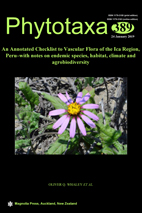Abstract
The ephemeral and fragmented nature of plant communities in the desert region of Ica, Peru have contributed to the poor documentation of its flora. This study provides the first comprehensive checklist and analysis of the vascular plants and habitats of the region, based on over 1800 herbarium collections, site-specific vegetation surveys and monitoring (2001–2017). Here, we report 501 taxa belonging to 283 genera in 68 families, with an outstanding number of taxa (297) representing new records for the region; over 10% of the flora (52 taxa) is categorised as threatened (CR, EN, VU). Asteraceae is the largest family in the checklist, followed by Poaceae, Fabaceae and Solanaceae. The highest species richness is found in quebradas and huaycos (170 taxa), followed by lomas (137 taxa) and huertas (115). Of the lomas taxa, 28% are assessed nationally as threatened, and 95 taxa (68%) are endemic to Peru. Across all habitats five species are restricted to the Ica region (Cleistocactus clavispinus, Haageocereus icensis, Onoseris humboldtiana, Nolana willeana, Tecoma fulva subsp. guarume). Nolana willeana, not collected since 1956, was rediscovered in 2006. We provide insights into habitat and taxonomic delimitation of enigmatic species in the following genera: Bulnesia, Capparis, Eremocharis, Hoffmannseggia, Leptoglossis, Lomanthus Maytenus, Poissonia and Weberbauerella, among others. We support the reinstatement of Prosopis limensis as a valid species and provide information for its identification in the field. Analysis of Inga feuillei as an ancient domestication vital to agriculture, is provided, and we report an additional 127 cultivated species associated with traditional agriculture, assessing origins and conservation priority. We present climatic and geological observations for the region with spatial and ENSO-related research from data, plots and transects. A vegetation map and niche model are provided. Threatened lomas species are detailed to support conservation and policy. To aid identification we provide photographs of 155 plant species and all key habitats. The sustainable wellbeing of the Ica region depends on concerted collaboration to monitor, conserve and restore native plants wisely for the natural resources they provide to people and agriculture.

